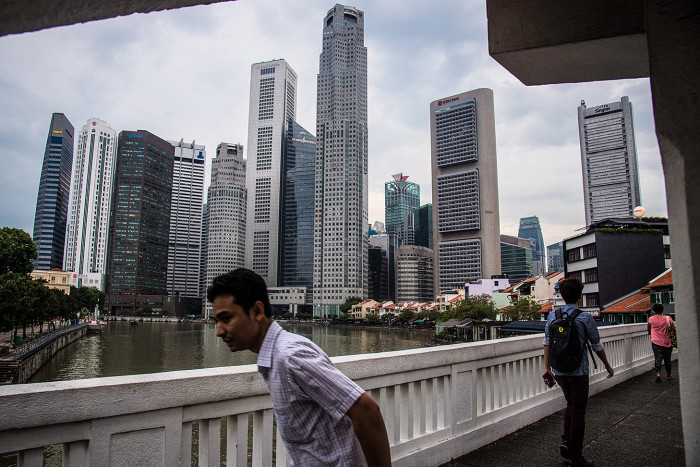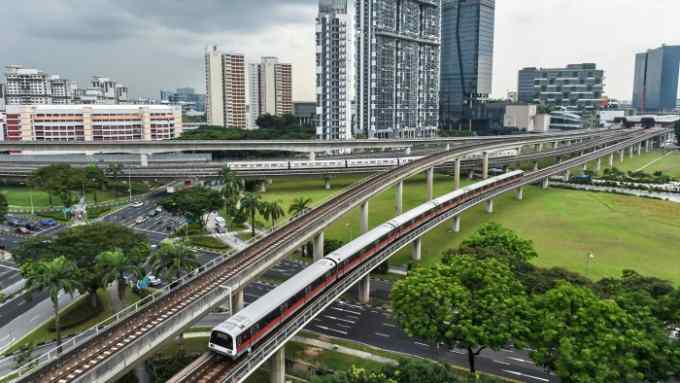How Singapore is battling ‘existential’ climate threat

Simply sign up to the Climate change myFT Digest -- delivered directly to your inbox.
One word crops up repeatedly in Singaporean authorities’ discussions on the environmental risks facing the low-lying country: “existential”.
An island nation half the size of London with limited natural resources, Singapore is vulnerable to rising sea levels and flooding, with food and water security major concerns. A spat with Malaysia over an accord that has underpinned water exports to Singapore for almost six decades has compounded the sustainability challenge.
However, Singapore has rolled out some of the world’s most progressive policies to tackle climate change risks as well as encouraging businesses to harness technology to address them.
“The effects of climate change are real, and in Singapore we are definitely going to be facing them,” says Pamela Lee, director of policy and planning at the National Climate Change Secretariat in the prime minister’s office.
“One of the key things Singapore has been undertaking is using innovation and technology to overcome our constraints and challenges.”
Rising sea levels are an area of concern. By 2100, Singapore’s mean sea levels could rise by up to 1 metre, according to the ministry for the environment and water resources. Storms 2,000km away in the South China Sea can trigger jumps in Singapore’s sea levels of up to 40cm for several hours, says Adam Switzer, associate chair of the Asian School of the Environment at Nanyang Technological University.
“The future of extreme sea level events in the region [remains] very uncertain,” says Mr Switzer. “In Singapore we have the potential to engineer solutions to extreme sea levels, but we need a much better idea of what we are going to be up against over the next 50 years or so.”
The city state has raised minimum levels for reclaimed land to four metres above mean sea level. It will also launch a national sea-level programme before the year-end to “develop robust projections and plans for the long term”, says Masagos Zulkifli, minister for the environment and water resources.
To decrease the impact of flooding, Singapore has implemented a system that reroutes rainfall into a river via a tank that can store 15 Olympic-sized swimming pools of stormwater.
With Singapore authorities forecasting a jump of up to 4.6C in daily mean temperatures in the next century and extreme weather increasing the likelihood of flash floods, a second challenge is looming: food security. “[We need to strengthen] food security in the face of possible supply disruptions,” says the ministry of the environment and water resources.
Singapore is enlisting the help of the private sector via the Economic Development Board, a government agency.
“Traditionally you would think of the EDB as attracting investment,” says chairman Beh Swan Gin. While that is still important, he says the agency increasingly will look to “foster partnerships between companies that may be in very different sectors but have complementary capabilities that could result in new products” in industries such as agricultural and food technology.
Mr Beh notes that there are several billion people in Asia “all wanting to increase their protein consumption. The world cannot sustain that . . . How do you come up with protein substitutes that can really address this need?”
Shiok Meats believes it can help. The Singapore-based start-up is backed by Henry Soesanto, chief executive of Monde Nissin, the Philippines food group that owns UK meat substitute maker Quorn.
Rather than relying on animals, the company grows meat in a lab from cells of crustaceans such as prawns and crabs. “We use stem cells from a small part instead of the entire animal,” says co-founder Ka Yi Ling in a video. “We believe that cell-based meats [are] the future of food and a sustainable solution for human health, the welfare of animals and our environment.”
Companies such as Shiok could help Singapore reach its target of producing 30 per cent of its nutritional needs locally by 2030.
“In Singapore, where most of our food is imported, producing our own seafood and meats by using cells contributes to the zero-miles mandate,” says Sandhya Sriram, Shiok co-founder.
In the case of water security, disruptions have already materialised. Singapore, which is not self-sufficient in water, is in a stand-off with Kuala Lumpur after Malaysia’s prime minister Mahathir Mohamad last year demanded a higher price for the water it sells to the city state.
The countries’ leaders earlier this year called for an “amicable solution” that might involve “dispute resolution through arbitration on a mutually agreed basis”.
If unresolved, the dispute could be catastrophic for Singapore, whose water demand will double to 3.2bn litres per day by 2060, according to Public Utilities Board (PUB) estimates.
Imported water is critical to Singapore’s efforts to fill the supply gap, together with its own recycled, reclaimed, desalinated and local catchment water.
“We believe the future of Singapore’s water security lies in using science, innovation and technology,” says the PUB. One area of study involves engineering systems mimicking natural desalting processes found in euryhaline fish — organisms that can adapt to a range of salinities — or mangrove plants.
But long-term water sustainability requires efficient usage and increased supply, adds the PUB. Singapore wants to cut daily domestic water consumption from 141 litres per person in 2018 to 130 litres by 2030, via public education campaigns.
“Water has been and continues to be an existential issue for Singapore,” PUB says.

Comments